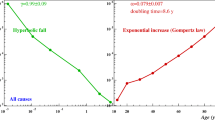Abstract
Study of the lifespans of normal (non mutant) mice and growth delay mutants has shown that mortality rates for both kinds of animals exhibit reproducible fluctuations. In the case of the mutant mice, the positions of peaks on the differential mortality curves (mortality rate plotted against lifespan) coincided in different-sex groups of animals and in same-sex subgroups of animals. Differential mortality curves of the mutant mice also had a peak at 1 month of age that was absent from the differential mortality curves of the normal mice. In the case of normal animals, positions of most peaks were the same in the studied independent subgroups of males, and to a lesser extent – independent subgroups of females, which might be explained by a shift in mortality peak positions due to the reproductive activity of females. Similar positions of mortality rate peaks in the differential mortality curves for animals from independent groups and subgroups indicate the existence of increased risks of death at specific ages. The observed pattern could be due to the programming in the genome of both the periods of increased risk of death and the intermitting intervals of stable development.
Similar content being viewed by others

References
Malygin, A. G. (2012) Variations in the lifespan of mice during the periods of growth and aging, Dokl. MOIP Sekt. Gerontol., 50, 56–65.
Malygin, A. G. (2012) Oscillation in the survivorship of mice during growth and aging, in Problems of Biosphere Origin and Evolution [in Russian], Pt. 2 (Galimov, E. M., ed.), KRASAND, Moscow, pp. 635–639.
Malygin, A. G. (2013) Graduated change of life expectancy in mice ontogenesis, Russ. J. Dev. Biol., 44, 48–55.
Malygin, A. G. (2013) Age fluctuations in mortality of mice with mutation causing growth retardation, Biochemistry (Moscow), 78, 1033–1042.
Gompertz, B. (1825) On the nature of the function expressive of the law of human mortality and on a new mode of determining the value of life contingencies, Phil. Trans. R. Soc., 115, 513–583.
Mylnikov, S. V., Oparina, T. I., and Bychkovskaya, I. B. (2015) On the discontinuous character of annuity curves. Communication Deviations from the Gompertz law in Drosophila melanogaster Canton-S line, Usp. Gerontol., 28, 624–628.
Malygin, A. G. (2016) Reproducible peaks in differential mortality curves of mice as a reason for searching for analogous regularities in primates, in Fundamental and Applied Aspects of Medical Primatology: III Int. Conf., Sochi-Adler, August 8-10, 2016, Vol. 1, pp. 75–87.
Lamb, M. J. (1977) Biology of Aging, Blackie, Glasgow.
Vikhert, A. M., and Laune, B. (eds.) (1982) Materials of the 2nd Soviet-American Symp. Sudden Death, December 6-8, 1979, Indianapolis; Meditsina, Moscow.
Ziuganov, V. V. (2005) A paradox of a parasite prolonging the life of its host. Pearl mussel can cancel the accelerated aging program in salmon, Izv. Akad. Nauk. Ser. Biol., 4, 435–441.
Skulachev, V. P., and Longo, V. D. (2005) Aging as a mitochondria-mediated atavistic program. Can aging be switched off? Ann. N. Y. Acad. Sci., 1054, 145–164.
Khalyavkin, A. V. (1998) Organism–environment interaction and causes for aging, Usp. Gerontol., 2, 43–48.
Author information
Authors and Affiliations
Corresponding author
Additional information
Original Russian Text © A. G. Malygin, 2017, published in Biokhimiya, 2017, Vol. 82, No. 7, pp. 1085–1096.
Rights and permissions
About this article
Cite this article
Malygin, A.G. New data on programmed risks of death in normal mice and mutants with growth delay. Biochemistry Moscow 82, 834–843 (2017). https://doi.org/10.1134/S0006297917070094
Received:
Revised:
Published:
Issue Date:
DOI: https://doi.org/10.1134/S0006297917070094


